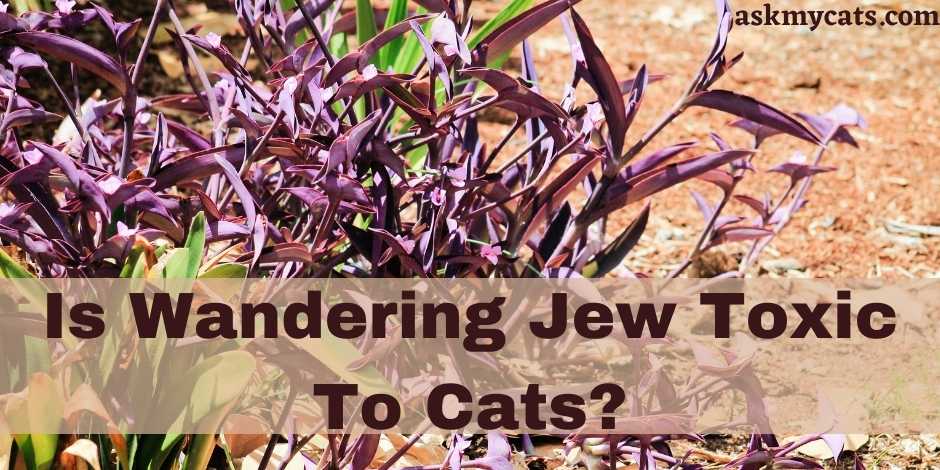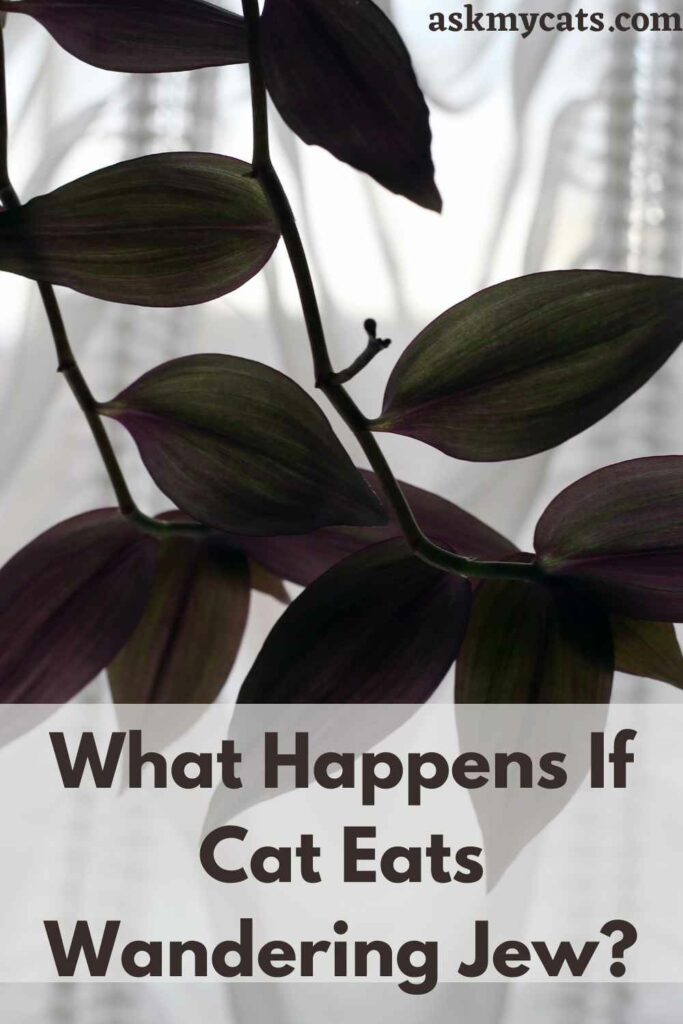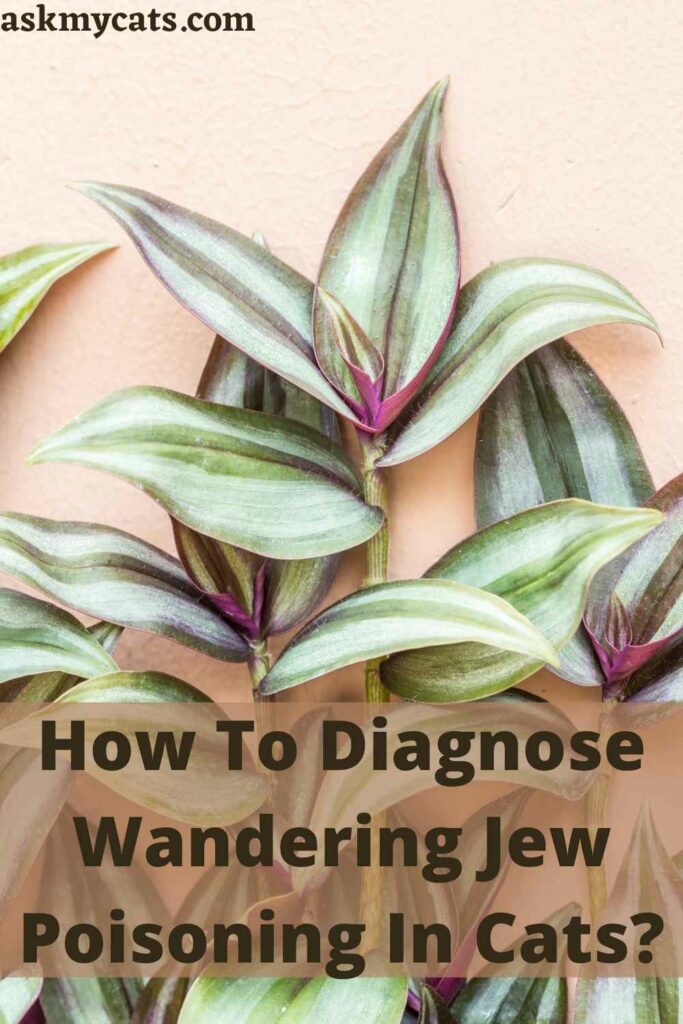If you love house plants but also have house cats, it’s crucial to ensure that the former isn’t toxic to the latter. The Wandering Jew (Tradescantia) is a tropical plant that thrives in warm climates.
The Tradescantia genus has approximately 75 herbaceous perennial species, which is used for several of them. Some are considered invasive weeds, while others are often used as outdoor garden plants. Many are popular container plants for indoors.
However, is wandering Jew Toxic To Cats?
Yes, wandering jew is toxic to cats. According to the ASPCA (American Society for the Prevention of Cruelty to Animals), the wandering jew has calcium oxalate crystals in its leaves and stems, which can be harmful to cats. Although it is unlikely to cause significant harm to your cat, chewing on it can cause discomfort.
In cats, this mildly poisonous plant can cause skin or gastrointestinal discomfort. If your cat consumes any part of the plant, especially the stem, it might induce diarrhoea or vomiting.
This article will discuss why wandering jew is toxic to cats and how to keep cats away from it.


Give Your Cat the Perfect Day
Get the Free Ebook!
What Is Wandering Jew?
Wandering Jew is an umbrella term for many different species of the Tradescantia genus, a tropical herbaceous plant originating in central and Southern America. It is a relatively easy plant to take care of, making it a popular houseplant.
Wandering jew are prized for their rapid growth and bright leaves, which can be stripped with white, green, silver, or purple! They have trailing vines that flow from their base and are a relatively low-maintenance plant.
The inch plant (Tradescantia spp.) has several names. It was formerly known as the “Wandering Jew” plant, but this moniker has gone out of popularity in recent years due to the anti-Semitic tone of the European folklore to which it relates.
Given its capacity to grow quickly, we prefer to call this plant by its other name—inch plant—these days.
Wandering jew plants thrive in bright, indirect light and mild temperatures and are ideally adapted to home life.
T. fluminensis, with green or variegated leaves, and T. zebrina, with purple- and silver-striped foliage, are the two most widely planted as houseplants.
Both of these tropical species are native to the Americas; however, they may be considered invasive in warm locations outside of their natural habitats (including in parts of the southeastern U.S.)
Is Wandering Jew Poisonous To Cats?
Yes, wandering jew is mildly poisonous to cats.

The Wandering Jew (Tradescantia) is a tropical plant that grows in warm climates.
This term is used for various species in the Tradescantia genus, which has approximately 75 herbaceous perennial species.
Some are considered invasive weeds, while others are popular as outdoor garden plants. Many are popular container plants for indoors.
It’s a simple plant that can grow in both sun and shade. However, the best growth is seen in partial shade and relatively damp soil.
Well-drained potting soil and a warm environment are ideal for indoor wandering Jews.
Window boxes, hanging baskets, and inventive pots can all be used to nurture plants. They appear best flowing down from a high vantage point.
The plant’s stems contain sap that will irritate your cat’s digestive system. It’s vital to remember that eating the leaves usually doesn’t result in a harmful reaction. However, there’s no reason to take a chance when a portion of the plant is known to be hazardous.
Wandering Jew is a moderately harmful plant to cats and other pets. Cats that eat the sap of wandering jew plants can get skin irritation and intestine irritation, which can cause vomiting or diarrhoea; however, it is rarely fatal.
When you have plants and pets in the same house, you may worry if they are safe companions. It would be best to consider whether houseplants are poisonous to your pet and whether your pet can harm the plant.
Experts say the wandering jew has sap that can irritate a cat’s digestive tract if they eat part of the stem, but eating the leaves shouldn’t be a problem. However, we strongly encourage you to keep this plant out of your cat-friendly environment at all times.
Also, The Wandering Jew plant is classified as Toxicity Class 4 by UCANR, which implies its sap juice is hazardous to the skin and causes irritation.
If your cat eats a wandering jew stem by accident, it may cause stomach trouble, but that does not mean it is not toxic. If your cat is exhibiting symptoms, you should seek assistance from a veterinarian.
What Happens If Cat Eats Wandering Jew?
If your cat ats wandering jew, the most apparent symptom, according to ASPCA, is a dermatitis-like skin irritation developing.

Look for these areas on your pet to be affected first:
- Groin
- Stomach, due to laying on the plant
- Under your pet’s chin
- Any other body part that comes into contact
The sap of the wandering jew plant is unpleasant to the skin, and if swallowed by your cat, it can also cause digestive irritations.
As a result, wandering jew is classified as a somewhat hazardous plant for cats, dogs, horses, other pets, and people.
The calcium oxalate crystals in the plant sap are what induce the allergic reaction in cats. The fluid can be found in the leaves, but most of it is located in the stem.
If any of the sap gets on your cat’s skin, it might produce a rash akin to dermatitis. It can cause intestinal irritations if your cat nibbles on the plant and ingests some of the sap.
These are some of the symptoms that cats may experience after coming into touch with wandering jew sap: –
- Skin irritations, especially on belly, paws, chin, groin
- Allergic skin reaction
- Vomiting
- Diarrhoea
Notify your veterinarian if you observe any of these signs in your cat. If your cat is displaying symptoms of intestinal irritation, the vet can advise you on how to ease the irritations and what to do next.
How To Diagnose Wandering Jew Poisoning In Cats?
You can diagnose wandering jew poisoning in cats by keeping a close eye on them for potential symptoms.

The name of the irritant produced by the wandering jew plant is not known.
Scientists only know that walking through the plant produces allergic dermatitis in cats and other animals.
Symptoms might occur as a result of unintentional contact and when the substance is used for scientific research.
In cats, the wandering jew does not always elicit a poisonous reaction but rather an allergic reaction.
Although there have been no reports of a cat ingesting this plant, it is possible that if she does, she will experience redness, itching, and irritation of the mouth.
Take your cat to the veterinarian if you find his skin is red, he’s scratching a lot, or he’s losing his fur.
Upon arrival, the veterinarian will do a physical examination. She’ll keep track of all of his symptoms and check his vitals for any irregularities.
She may then proceed to scrape a sample of your cat’s skin. She’ll scrape out a thin layer of your cat’s skin with a scalpel blade to examine under the microscope.
This will enable her to examine the skin for external parasites or bacterial overgrowth, both of which can cause dermatologic symptoms.
The veterinarian may order blood tests for diagnostic purposes. It is symptomatic of an allergy when a specific white blood cell level (eosinophil level) increases.
She will determine if this is the case by performing a complete blood count (CBC). She may also order a chemical panel to get a general picture of your cat’s health and see how his internal organs are working, especially if she feels a toxin is to blame for his symptoms.
When speaking with your veterinarian about your cat’s symptoms, make sure to include any and all specifics about what he was doing before the symptoms developed.
Tell her if you went for a walk; if he was romping around in a field with strange plants, tell her. While it may appear insignificant to you, it could be crucial to the correct diagnosis.
How To Treat Wandering Jew Poisoning In Cats?
The treatments of wandering jew poisoning begin with ointments or tablets prescribed by the vet.
If your cat is scratching excessively, your veterinarian will prescribe an ointment or medications to help. You may need to use a lotion two to three times per day, but it has been shown to be effective.
If your cat scratches frequently, he may develop a secondary skin infection, which will necessitate medicines. A buster collar, as well as shortening claws, can help to reduce self-trauma.
Depending on your cat’s needs, the veterinarian may decide to give him intravenous or subcutaneous fluids.
If his mouth has been impacted and he cannot eat or drink, this is more likely. While he waits for his symptoms to go away, the fluids will keep him hydrated.
If his eyes become irritated, she may recommend rinsing them or prescribing an ointment or drops for you to use at home for a few days.
How To Keep Cats Away From Wandering Jew?
You can keep cats away from wandering you by following these tips: –
- Use Citrus Repellents
Lemon and citrus fruits, in general, are disliked by cats (like orange or tangerine). While essential oils such as orange and lemon can be toxic if overused, using a DIY zest repellant is harmless.
Bring a litre of water to a boil with lemon or orange zest, then infuse for ten minutes before filtering. Spray the finished mixture around the house once it has cooled. Repeat the procedure as needed — moreover, it smells delicious.
- Use Coffee Grounds
This is a simple trick to perform. Coffee grounds can also be used as a fertilizer for your plants. Collect your coffee grinds in a container and set them at the base of the plants or flowerpots you’re working with.
Repeat as needed to keep the gadget working correctly, and discard the grounds if they begin to mould.
- Use Mustard Repellent
Mustard is a beautiful cat repellent: dilute a few spoons in water and spray it on plants where your cat is wreaking havoc. Then, using a spray, saturate the area with the repellent and repeat the process every 2 days.
Pepper is also effective at keeping cats away from your lovely plants. To get the best results, use freshly ground black pepper or a commercially purchased pepper mill if that’s not possible. Then sprinkle your cat’s preferred plants.
The only disadvantage is that the pepper fragrance does not remain long. As a result, you’ll need to sprinkle regularly to keep your cat away from your plants.
Alternatively, you can dissolve two tablespoons of crushed fresh pepper in a cup of hot water, let it sit for a few minutes, and then thoroughly combine everything before filtering. Then, using a spray bottle, squirt the solution.
- Use Anti-Cat Aromatic Herbs
Rosemary, lavender, and lemon thyme are scented herbs that are easy to grow and excellent cat repellents.
They can be cultivated alongside the plantings to be preserved in the garden. Alternatively, after steeping for several hours in 3 cups of hot water with a pinch of cinnamon, you can use dried rosemary and lavender in a spray bottle.
Using a strainer, strain the mixture and add a splash of white vinegar. Everything should be well shaken. Your natural insect repellent is now ready to use.
Frequently Asked Questions
How long do cats take to recover from wandering jew poisoning?
Take your cat to the veterinarian if he is scratching excessively and has a skin irritation or rash. If you can stop him from scratching before it grows into a skin infection, he will heal much more quickly and with fewer drugs. The wandering jew’s toxicity is considered minor. Cats usually recover well with supportive therapies since poisoning symptoms typically present as some kind of dermatitis. If you know you have this plant on your property or nearby, the best thing you can do for your cat keep him away from it. If you like, you can remove this plant from your property as soon as you detect it; the sooner you do it, the better, as it grows quickly.
Which part of wandering jew is most poisonous to cats?
Most species of the Tradescantia genus have sap that irritates the skin. Although the American Society for the Prevention of Cruelty to Animals (ASPCA) does not identify Tradescantia zebrina as hazardous, it lists a related relative, Tradescantia fluminensis (also known as Wandering Jew), as a skin irritant in cats, dogs, and horses.
What are the most common types of wandering jew?
Tradescantia fluminensis, Tradescantia Pallida, and Tradescantia Zebrina are the most common types of wandering jew. Tradescantia Flumensis has oval green and lilac striped leaves and is an evergreen perennial plant. It produces a three-petaled white bloom. Tradescantia Pallida has long, pointed purple leaves with crimson or green points. Produces 3-petaled flowers in purple, white, or pink in various colours. Tradescantia Zebrina is an evergreen perennial vine with multicoloured leaves that range from green to grey to purple. It produces pinkish blooms and has two light grey lines in the centre of the leaf.
Final Words
Cats are somewhat poisoned by wandering jew. Ingesting the sap is the problem. Even while it is unlikely to cause significant illness, this is not a good idea if your cat enjoys eating plants. If you’re seeking non-toxic plants, check out the list of cat-safe houseplants at the ASPCA website.
If you have any questions, ask us in the comments section.
